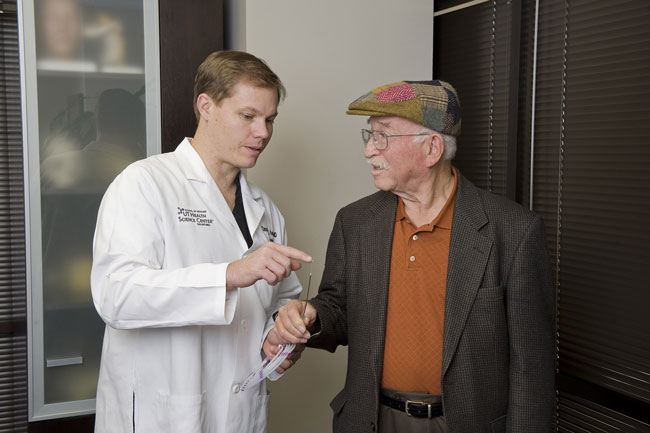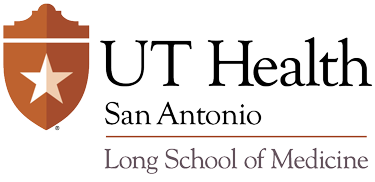Device retrieves clot, helps retired bus mechanic beat stroke

Patricia Ozuna can tell you all about the night her husband, Lino, suffered a stroke. The couple lay in bed at 1:15 a.m. on Oct. 2, 2009, when Patricia felt his body lean into hers. “I said, ‘Lino, you’re squashing me.’ It didn’t take me more than a minute to realize something was wrong. He was looking at me and talking, but I couldn’t understand him.”
Lino Ozuna, a retired San Antonio bus mechanic, doesn’t smoke and eats right. He is usually happy and friendly. Mrs. Ozuna quickly called her son, Richard, a San Antonio paramedic trainer. “I said, ‘He’s very heavy, like dead weight, and he is babbling at me.’
“Richard said, ‘Mom, go to the door. Someone will be there in a minute.’”
Brain & Stroke Network
Mr. Ozuna was completely paralyzed on his left side when Christopher Koebbe, M.D., clinical assistant professor of neurosurgery at The University of Texas Health Science Center at San Antonio, greeted him at the hospital. Dr. Koebbe is one of the dedicated team of Health Science Center faculty neurosurgeons who treat stroke patients 24 hours a day, seven days a week, through the Brain & Stroke Network at Baptist Health System. He is also on active duty in the U.S. Air Force.
Special coil used to remove clot
| Related link: View an animation of the Merci Retrieval System® |
At St. Luke’s Baptist Hospital a block from the Health Science Center, Dr. Koebbe used a Merci Retrieval System®* to remove the clot that had halted blood flow in Mr. Ozuna’s brain. The Merci system includes a wire snake with a coiled end like on a corkscrew wine opener. It is advanced from the groin through blood vessels to just past the site of the clot. Then the surgeon uses the coiled end to grab the clot and reels the snake back in.
Dr. Koebbe has done 50 such procedures as part of the Brain & Stroke Network. Follow-up visits are next door to the hospital in a UT Medicine San Antonio neurosurgery clinic. UT Health San Antonio Long School of Medicine is the faculty physician practice of the Health Science Center School of Medicine.
Sole San Antonio physician performing procedure
“Up to a year ago, no treatment like this was available in San Antonio, a city of 1.5 million people,” Dr. Koebbe said. “These therapies are available only at stroke tertiary care centers. There is no other person who does the technique in San Antonio.”
In the past, patients such as Mr. Ozuna were brought to emergency rooms with little hope of effective treatment. In the last 15 years, the clot-softening drug tPA (tissue plasminogen activator) has been administered in the first three hours after stroke onset and has helped many.
More time for recovery
The Merci system lengthens the window of possible effective stroke treatment.
tPA was administered to Mr. Ozuna within three hours of his stroke onset but his condition did not improve, Dr. Koebbe said. The team used CT perfusion imaging to show the area of Mr. Ozuna’s brain that was salvageable. “He was a good candidate for the Merci retriever because he still had considerable brain tissue left that was not dead,” the neurosurgeon said.
Quick action necessary for those with a stroke
This was because Mrs. Ozuna recognized the stroke immediately and called for help. In addition, Dr. Koebbe said he was able to retrieve the clot fairly early in the operation. “I got it on the first pluck,” he said.
Three days after the surgery, Mr. Ozuna was joking with his son, Richard, about doing engine work. The elder Ozuna spent 28 days in the hospital, mostly because of its convenient stroke rehabilitation unit.
Today, he walks and talks, drives to the store with lists from his wife, and even reminds her to take her medication. “I feel completely normal,” he said to Dr. Koebbe. “I feel very lucky you were handling my case.”
